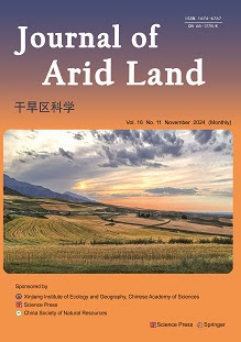Temporal and spatial responses of ecological resilience to climate change and human activities in the economic belt on the northern slope of the Tianshan Mountains, China
IF 3.1
3区 环境科学与生态学
Q3 ENVIRONMENTAL SCIENCES
引用次数: 0
Abstract
Abstract In the Anthropocene era, human activities have become increasingly complex and diversified. The natural ecosystems need higher ecological resilience to ensure regional sustainable development due to rapid urbanization and industrialization as well as other intensified human activities, especially in arid and semi-arid areas. In the study, we chose the economic belt on the northern slope of the Tianshan Mountains (EBNSTM) in Xinjiang Uygur Autonomous Region of China as a case study. By collecting geographic data and statistical data from 2010 and 2020, we constructed an ecological resilience assessment model based on the ecosystem habitat quality (EHQ), ecosystem landscape stability (ELS), and ecosystem service value (ESV). Further, we analyzed the temporal and spatial variation characteristics of ecological resilience in the EBNSTM from 2010 to 2020 by spatial autocorrelation analysis, and explored its responses to climate change and human activities using the geographically weighted regression (GWR) model. The results showed that the ecological resilience of the EBNSTM was at a low level and increased from 0.2732 to 0.2773 during 2010–2020. The spatial autocorrelation analysis of ecological resilience exhibited a spatial heterogeneity characteristic of “high in the western region and low in the eastern region”, and the spatial clustering trend was enhanced during the study period. Desert, Gobi and rapidly urbanized areas showed low level of ecological resilience, and oasis and mountain areas exhibited high level of ecological resilience. Climate factors had an important impact on ecological resilience. Specifically, average annual temperature and annual precipitation were the key climate factors that improved ecological resilience, while average annual evapotranspiration was the main factor that blocked ecological resilience. Among the human activity factors, the distance from the main road showed a negative correlation with ecological resilience. Both night light index and PM2.5 concentration were negatively correlated with ecological resilience in the areas with better ecological conditions, whereas in the areas with poorer ecological conditions, the correlations were positive. The research findings could provide a scientific reference for protecting the ecological environment and promoting the harmony and stability of the human-land relationship in arid and semi-arid areas.天山北坡经济带生态恢复力对气候变化和人类活动的时空响应
在人类世时代,人类活动日趋复杂和多样化。由于城市化和工业化的快速发展以及其他人类活动的加剧,特别是在干旱和半干旱地区,自然生态系统需要更高的生态恢复力来确保区域的可持续发展。在研究中,我们选择了中国新疆维吾尔自治区天山北坡经济带(EBNSTM)作为案例研究。通过收集2010年和2020年的地理数据和统计数据,构建了基于生态系统生境质量(EHQ)、生态系统景观稳定性(ELS)和生态系统服务价值(ESV)的生态恢复力评价模型。通过空间自相关分析,分析了2010 - 2020年EBNSTM生态恢复力的时空变化特征,并利用地理加权回归(GWR)模型探讨了EBNSTM生态恢复力对气候变化和人类活动的响应。结果表明:2010-2020年,林下森林的生态恢复力处于较低水平,从0.2732上升到0.2773;生态恢复力的空间自相关分析表现出“西高东低”的空间异质性特征,研究期间空间聚类趋势增强。荒漠、戈壁和快速城市化地区的生态恢复能力水平较低,绿洲和山区的生态恢复能力水平较高。气候因子对生态恢复力有重要影响。其中,年平均气温和年降水量是提高生态恢复力的关键气候因子,而年平均蒸散量是阻碍生态恢复力的主要气候因子。在人类活动因子中,距离主干道的距离与生态恢复力呈负相关。在生态条件较好的地区,夜间照明指数和PM2.5浓度与生态恢复力呈负相关,而在生态条件较差的地区,二者呈正相关。研究结果可为干旱半干旱区保护生态环境,促进人地关系和谐稳定提供科学参考。
本文章由计算机程序翻译,如有差异,请以英文原文为准。
求助全文
约1分钟内获得全文
求助全文
来源期刊

Journal of Arid Land
ENVIRONMENTAL SCIENCES-
CiteScore
4.70
自引率
6.70%
发文量
768
审稿时长
3.2 months
期刊介绍:
The Journal of Arid Land is an international peer-reviewed journal co-sponsored by Xinjiang Institute of Ecology and Geography, the Chinese Academy of Sciences and Science Press. It aims to meet the needs of researchers, students and practitioners in sustainable development and eco-environmental management, focusing on the arid and semi-arid lands in Central Asia and the world at large.
The Journal covers such topics as the dynamics of natural resources (including water, soil and land, organism and climate), the security and sustainable development of natural resources, and the environment and the ecology in arid and semi-arid lands, especially in Central Asia. Coverage also includes interactions between the atmosphere, hydrosphere, biosphere, and lithosphere, and the relationship between these natural processes and human activities. Also discussed are patterns of geography, ecology and environment; ecological improvement and environmental protection; and regional responses and feedback mechanisms to global change. The Journal of Arid Land also presents reviews, brief communications, trends and book reviews of work on these topics.
 求助内容:
求助内容: 应助结果提醒方式:
应助结果提醒方式:


